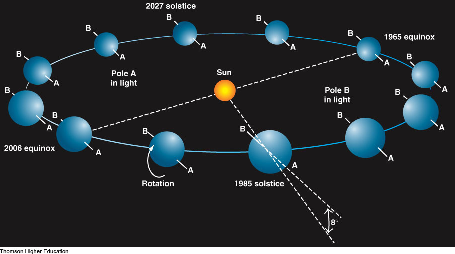[/caption]
The orbit of Uranus takes 84.3 year to complete one revolution around the Sun. In other words, 1 Uranian year is 84.3 Earth years.
Like the rest of the planets in the Solar System, Uranus doesn’t have a perfectly circular orbit. Instead, it follows an elliptical path around the Sun. Astronomers call a planet’s closest approach to the Sun perihelion. The perihelion for Uranus is 2.75 billion km, or 18.4 astronomical units (1 AU is the distance from the Earth to the Sun). The most distant point of orbit is called aphelion. The aphelion of Uranus is 3.00 billion km, or 20 astronomical units. On average, Uranus orbits at a distance of 2.88 billion km, or 19.2 AU.
Uranus is unique among the planets in the Solar System because of its axial tilt. While Earth is tilted at a mere 23.5 degrees, Uranus has rolled over completely sideways, with an axial tilt of 99-degrees. This has a significant impact on the planet’s seasons. The north pole of Uranus experiences 42 years of complete darkness, followed by 42 years of sunlight, where the Sun never dips below in the horizon. Astronomers aren’t sure why Uranus is flipped over sideways, but they think an impact from a protoplanet early in its history gave it the momentum it needed to roll over.
We’ve written many articles about Uranus for Universe Today. Here’s an article about how we got to see the planet’s rings edge on, and another about how the atmosphere of Uranus can be more violent than previously believed.
If you’d like more info on Uranus, check out Hubblesite’s News Releases about Uranus. And here’s a link to the NASA’s Solar System Exploration Guide to Uranus.
We have recorded an episode of Astronomy Cast just about Uranus. You can access it here: Episode 62: Uranus.

